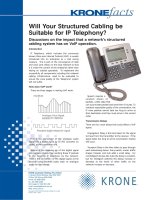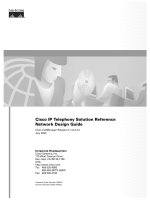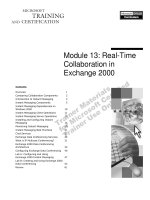Call Progress Time Measurement in IP Telephony
Bạn đang xem bản rút gọn của tài liệu. Xem và tải ngay bản đầy đủ của tài liệu tại đây (330.21 KB, 15 trang )
APPENDIX A
CALL PROGRESS TIME
MEASUREMENT IN IP TELEPHONY1
In IP telephony, a voice call is usually established through multiple stages. In
the first stage, a phone number is dialed to reach a near-end or call-originating
or ingress IP-telephony (or IP-PSTN) GW. The next stages involve user iden-
tification by delivering an m-digit user ID to the authentication and/or billing
server, followed by user authentication using an n-digit personal identification
number (PIN ). After that, the caller is allowed (a last-stage dial tone is pro-
vided) to dial the destination phone number, provided that authentication is
successful. This appendix presents a method for measuring call progress time
in IP telephony. The proposed technique can be used to measure the system
response time at every stage. It is flexible, so that it can be easily modified to
include a newly defined tone or set of tones, or a voice-band speech sample can
be used at every stage to detect the system’s response. The proposed method
has been implemented using scripts written in Hammer visual basic (HVB)
language (www.hammer.com) for testing with a few commercially available IP-
PSTN GWs.
INTRODUCTION
The first generation of IP-PSTN GWs allows voice call setup in single or mul-
tiple stages. The more stages involved, the longer the call setup time. The con-
figuration of a simple testbed, which can be used to measure call setup time, is
shown in Figure A-1.
137
1 The ideas and viewpoints presented here belong solely to Bhumip Khasnabish, Massachusetts,
USA.
The Hammer VoIP test equipment [1,2] is used for generating bulk tele-
phony calls and for analyzing the emulated black (or PSTN) phone to black
phone calls. This includes measuring the answer time, the response time at
various stages of call progress, and the time needed to hear the ring-back tone
at the call-originating side. The version of the Hammer tester we used in this
testbed can support a maximum of six T1 lines to a PSTN switch or PBX (e.g.,
a Madge Access Switch).
The ISDN BRI phones can be used to check the integrity of call progress
and human perception–based audio quality measurement. Call progress integ-
rity evaluation involves hearing the generation of appropriate tones (e.g., a
string of DMTF digits, a dial tone, a ring tone, etc.), playout of an appropriate
interactive voice response (IVR) message, and so on. The Madge (www.madge.
com, 2001) Access Switch is a small PBX and emulates a CLASS-6-type PSTN
central o‰ce (CO) switch. It provides one or more T1-CAS and/or T1-PRI
connection(s) to the PSTN-side interface(s) of the IP-PSTN GWs under test. A
set of ISDN BRI phones can be also directly connected to it.
The two 24-port EtherSwitches and the IP network impairment emulator,
which is a PC-based simple router (described in Chapter 5), comprise the
Intranet of the testbed. The EtherSwitches provide connectivity to the IP-side
interface(s) of the IP-PSTN GWs under test.
GW-A and GW-B are the near-end (call-originating or ingress) and far-end
(call-terminating or egress) GWs. Usually they are connected to two di¤erent
subnets, which are interconnected via the simple PC-based router mentioned
above. However, when necessary, it is also possible to connect the two GWs
Figure A-1 A simple testbed for measuring the call setup performance of IP-PSTN
GWs (E: Ethernet link; T1: CAS or PRI link; BRI: basic rate interface links. NTS:
network time server; it provides timing information (clock) to IP domain network
elements such as IP-PSTN GWs, GK, and NIST-Net, and if needed, it can derive
clocking information from a GPS receiver as well. A detailed description of the testbed
is presented in Chapter 5.
138
CALL PROGRESS TIME MEASUREMENT IN IP TELEPHONY
using the same subnet, that is, to connect them to the same EtherSwitch. The
gatekeeper (GK) usually runs on a WindowsNT server or a general-purpose IP
router and is connected to the same subnet to which the GW-A is connected. In
general, the GK performs registration, authentication, and status (RAS) mon-
itoring functions when a call establishment request arrives. If implemented, it
can also maintain the call detail record (CDR) files. The network time server
(NTS) provides timing information (clock) to the IP domain network ele-
ments such as IP-PSTN GWs, GK, and NIST-Net and, if needed, it can derive
clocking information from a global positioning system (GPS) receiver as well.
The Madge Access Switch used in the testbed can accommodate a maximum
of six 4- or 8-port line cards, with 4 ports in one card reserved for local/remote
configuration, network management, and timing management. The remaining
ports can be used for BRI and/or T1 (CAS or PRI) connections. Currently,
we are using two 8-port cards for connections to BRI phones and the other
ports to support T1 connections. The six T1 ports of the Madge Access Switch
are connected to the AG-T1 cards of the Hammer using T1-CAS lines. The
remaining T1 ports of Madge can be used to connect to either one or three
pairs of the GWs under test. Appropriate dialing plans and Madge configura-
tions are used to make telephony connections from one Hammer channel or
BRI phone to the other, either directly through Madge or using one or two IP-
PSTN GWs. These options o¤er the flexibility to make calls over the PSTN
network/switch alone or through the IP network with incorporation of very
little (i.e., when both IP-PSTN GWs are connected to the same subnet) or a
controlled amount of impairments like delay jitter, packet loss, bandwidth
restrictions, and so on. These impairments are added using an IP network
impairment emulator, NIST-Net (described in Chapter 5).
The call processing performance of an IP-PSTN GW can be described in
terms of the following two factors. The first one is the total amount of time it
takes to set up a call, measured from the moment the last digit of the first-stage
dialing number is entered to the time the ring-back tone is heard at the call-
originating side. This is known as the call setup time, and it is discussed in this
appendix. Various components of the call setup time are shown in Figures A-2
and A-3. The second factor is the number of simultaneous calls that can be
handled by a GW without any precall wait. Note that the precall waiting time
can vary from as little as 1 sec to as much as 10 sec. This is discussed in
Appendix B.
DESCRIPTION OF THE TECHNIQUE
The technique discussed here consists of two phases of evaluation. The first
phase involves determining the tone(s) indicating the completion of one stage
of dialing so that the beginning of the next stage of dialing can be detected. If
an IVR file is played then, any indication of ‘‘voice begin’’ can be used as an
indication of the beginning/end of a stage. For example, in some implemen-
DESCRIPTION OF THE TECHNIQUE
139
tations, one or more DTMF digits (e.g., a series of 7s or 9s) are used to indicate
the first stage’s response, while in others, DTMF digit(s) followed by a con-
tinuous tone—which could be a modified or bona-fide dial tone—are used. It
is therefore important to determine this tone, either from the manufacturer’s
specifications or through trials and testing. We utilize some rudimentary addi-
tion, detection, and tuning of the tones to detect the readiness of the next stage
(of dialing) to accept the incoming digit strings. The upper and lower frequen-
cies and the tolerances (which can vary from G1toG100 Hz) at the boundary
Figure A-2 Multistage call setup using PIN-based caller authentication. The user iden-
tification stage (response time, t2) is not shown here. The call setup time is computed as
t11 þ t12 þ t3 þ t4. The after_bbb and after_dialTone pauses allow stabilization of the
system’s response.
Figure A-3 Two-stage call setup where caller authentication is not needed. The call
setup time is computed as t11 þ t12 þ t4. The after_dialTone pause allows stabilization
of the system’s response.
140
CALL PROGRESS TIME MEASUREMENT IN IP TELEPHONY
of a DTMF tone, and its detection widow size (which can vary from 2 to 10
msec or more) need to be properly adjusted to use this feature e¤ectively. Note
that in the United States, the ring tone is defined as a combination of two tones
(frequency 1 ¼ 440 Hz, frequency 2 ¼ 480 Hz) with on-time of 2 sec and o¤-
time of 4 sec, the dial tone is a combination of two tones (frequency 1 ¼ 350
Hz, frequency 2 ¼ 440 Hz) played continuously, and the busy tone is a com-
bination of two tones (frequency 1 ¼ 480 Hz, frequency 2 ¼ 620 Hz) with on-
time of 0.5 sec and o¤-time of 0.5 sec.
In the second phase, it is necessary to read the exact timestamps (the finer the
resolution, the greater the accuracy of measurement) of the required telephony
events. These timestamps are used to measure the elapsed time between various
call progress events. For example, the time di¤erence between the telephony
event ‘‘last digit entered’’ in the first stage of dialing and the telephony event
‘‘first indication of remote answer’’ determines the response time of the first
stage.
The ‘‘first indication of remote answer’’ usually follows one or more tones
or playout of a voice prompt. This indicates that the system is now ready to
accept the PIN and/or user ID from the caller to authenticate the caller. This
information can also be used for billing or/and call routing purpose(s).
Once the authentication stage is complete, the caller is prompted with a sec-
ond dial tone, and that’s when the caller enters the telephone number (4-digit,
7-digit, or 10-digit, as required) of the destination phone, that is, the called
party’s terminal. If a valid destination phone number is dialed, the calling party
can expect to hear the standard ring-back tone. However, since the transmis-
sion medium is IP, a correct/precise ring-back tone may not be heard at the
call-originating side. Once again, it is important to find out the exact definition
of the ring-back tone either from the manufacturer’s specifications or through
trials and testing. Note that all of the standard test and measurement equip-
ment is calibrated or tuned to detect the standard ring-back tone, but none of
the IP-PSTN GWs may be capable of delivering it unless a very-high-quality
digital phone (e.g., an ISDN BRI phone) is used by the called party.
A description of time measurement in each of the stages is now presented,
along with a definition of each telephony event. We are assuming that each
event has an embedded member (as available in HVB) for extracting the time-
stamp with an acceptable level (e.g., milliseconds or less) of resolution.
In the first stage, a 7- or 10-digit telephone number is entered to reach the
call-originating (ingress or near-end) IP-PSTN GW. The response time for this
stage is the di¤erence between the time the last digit of the digit string is entered
and an indication of an answer from the remote end (i.e., the IP-PSTN GW).
Note that if the ‘‘indication of remote answer’’ is the playout of an IVR mes-
sage, it is necessary to wait until the voice playout is completed. This sequence
is shown in Figure A-4.
Next, it is necessary to determine the response time needed to allow the user
to provide input for identification via a user-id (4 to 8 digits, for example) and
then get a result. The response could be a standard dial tone, a vendor-specific
DESCRIPTION OF THE TECHNIQUE
141
tone or set of tones, or simply the beginning of a voice prompt announcing that
the caller is now in the identification phase. Here again, the identification of
‘‘voice begin’’ may be easier than pinning down the tone or set of tones, espe-
cially when IP transport is used. This sequence is shown in Figure A-5.
If the identification is successful, the caller can proceed to the next stage, and
an IVR or dial tone will be heard. A failed identification may result in a busy
tone or a di¤erent IVR message.
It is then necessary to determine the response time needed to allow the user
to provide input for authentication (e.g., via the use of a 4- to 8-digit PIN). The
response could be a standard dial tone, a vendor-specific tone or set of tones, or
simply the beginning of a voice prompt announcing the result of authentica-
tion. Here again, the identification of ‘‘voice begin’’ may be easier than pinning
down the tone or set of tones, especially when IP transport is used. The steps
are shown in Figure A-6.
If the authentication is successful, the caller can proceed to the next stage,
and an IVR or dial tone will be heard. A failed authentication may result in a
busy or fast-busy tone or a voice announcement.
1 Set telephonyEvent ¼ placingACall (a number with # sign at the end, e.g.,
97814662080#)
2 Set telephonyEvent1 ¼ getCallEvent (ALL_DIGITS_SENT)
3 Set telephonyEvent2 ¼ getCallEvent(REMOTE_ANSWERED)
4 Set telephonyEvent3 ¼ getCallEvent(TONE or Voice_Begin)
5 If voice_begin is used, one must wait for voice_end before beginning the next
action, and for detecting the remote_answer_tone, tolerance of DTMFs and/
or the detection window size may need to be adjusted
6 FirstStageResponseTime, t1 or (t11 þ t12) ¼ (telephonyEvent3.time À
telephonyEvent1.time)
Figure A-4 Description of the measurement of first-stage response time.
1 Set telephonyEvent4 ¼ sendingADtmfString (a string of digits with # sign at
the end, e.g., "1234#")
2 Set telephonyEvent5 ¼ getCallEvent(REMOTE_ANSWER_TONE or
Voice_Begin)
3 If voice_begin is used, one must wait for voice_end before beginning the next
action, and for detecting the remote_answer_tone tolerance of DTMF and/or
detection window size may need to be adjusted
4 SecondStageResponseTime, t2 ¼ (telephonyEvent5.time À telephonyEvent4.
time)
Figure A-5 Description of the measurement of second-stage response time.
142
CALL PROGRESS TIME MEASUREMENT IN IP TELEPHONY









